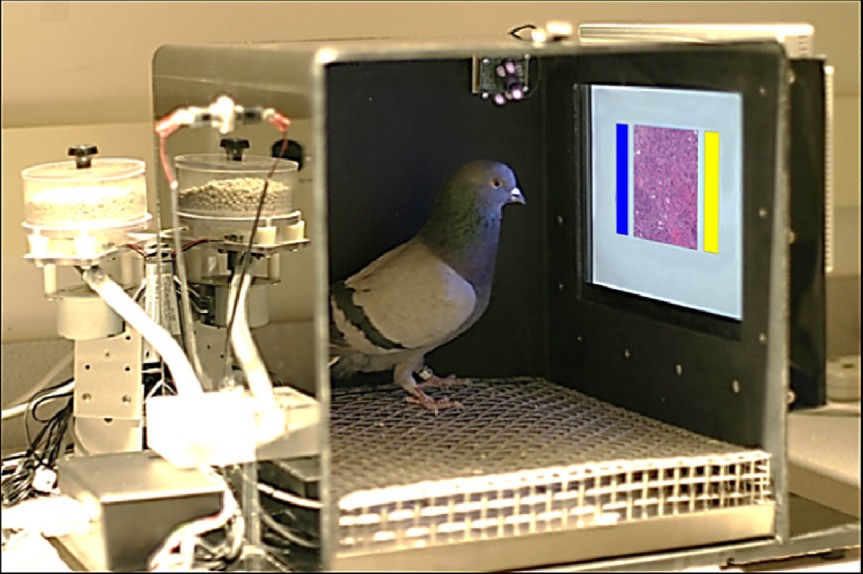
From Levenson et al. (2015), doi: 10.1371/journal.pone.0141357. License: CC BY 4.0
Pigeons have amazing visual skills. They can remember facial expressions, recall almost 2000 images, recognizes all the letters of the alphabet (well, even I can do that), and even tell apart a Monet form a Picasso! (ok, birdie, you got me on that one).
Given their visual prowess, Levenson et al. (2015) figured that pigeons might be able to distinguish medically-relevant images (a bit of a big step in reasoning there, but let’s go with it). They got a few dozen pigeons, starved them a bit so the birds show motivation to work for food, and started training them on recognizing malignant versus non-malignant breast tumors histology pictures. These are the same exact pictures your radiologist looks at after a mammogram and your pathologist after a breast biopsy; they were not retouched in any way for the pigeon’s benefit (except to make it more difficult, see below). Every time the pigeon pecked on the correct image, it got a morsel of food (see picture). Training continued for a few weeks on over 100 images.
For biopsies, the birds had an overwhelming performance, reaching 99% accuracy, regardless of the magnification of the picture, and for mammograms, up to 80% accuracy, just like their human counterparts. Modifying the pictures’ attributes, like rotation, compression or color lowered somewhat their accuracy, but they were still able to score only marginally less than humans and considerably better than any computer software. More importantly, the pigeons were able to generalize, after training, to correctly classify previously unseen pictures.
Let’s be clear: I’m not talking about some fancy breed here, but your common beady-eyed, suspicious-sidling, feral-looking rock pigeon. Yes, the one and only pest that receives stones and bread in equal measures, the former usually accompanied by vicious swearings uttered by those that encountered their slushy “gifts” under the shoes, on the windshield or in the coffee and the latter offered by more kindly disposed and yet utterly naive individuals in the misguided hopes of befriending nature. Columba livia by its scientific name, at the same time an exasperating pest and an excellent pathologist! Who knew?!
The authors even suggest using pigeons instead of training and paying clinicians. Hmmm… But who do I sue if my mother’s breast cancer gets missed by the bird, in one of those 1% chances? Because somehow making a pigeon face the guillotine does not seem like justice to me. Or is this yet another plot to get the clinicians off the hook for misdiagnoses? Leave the medical profession alone, birdies – is morally sensitive as it is -, and search employment in the police or Google; they always need better performance in the ever-challenging task of face-recognition in surveillance videos.
P.S. The reason why you didn’t recognized the word “avesophobe” in the title is because I just invented it, to distinguish the hate for birds from a more serious affliction, ornithophobia, the fear of birds.
Reference: Levenson RM, Krupinski EA, Navarro VM, & Wasserman EA (18 Nov 2015). Pigeons (Columba livia) as Trainable Observers of Pathology and Radiology Breast Cancer Images. PLoS One, 10(11):e0141357. doi: 10.1371/journal.pone.0141357. Article | FREE FULLTEXT PDF
By Neuronicus, 19 November 2015

